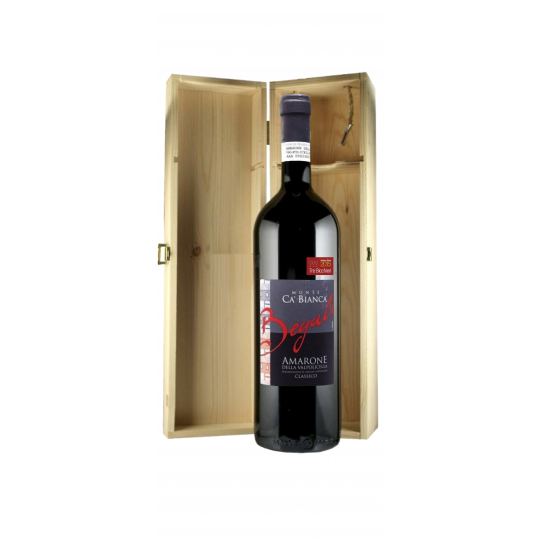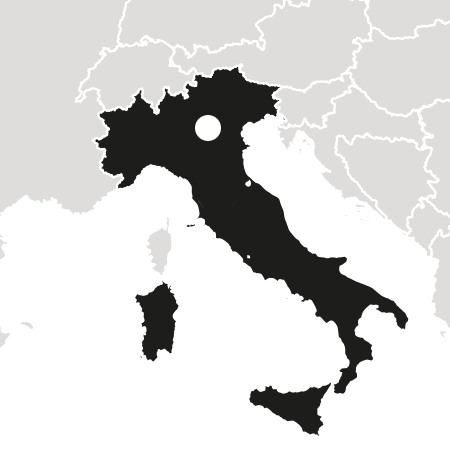Waarom deze wijn?
Van de één van de mooiste wijngaarden; Amarone 'Ca'Bianca', volgens Robert Parker 'the nicest Amarone wine of the year.'
De laatste kisten zijn exclusief beschikbaar voor SlimmerWijnKopen.
De smaak
Intens robijnrode wijn met een prachtige geur: rijp roodfruit, kersen, zwarte bessen en met prachtige 'spicyness.' De is smaak overweldigend: droog, krachtig, vol, fluweelzacht. Een prachtige balans met rijpe zachte tannines en een warme lange afdronk.
De details
type wijn: complex, in balans, warm en zeer rijk
druivensoort: Corvina 40%, Corvinone 35%, Rondinella 20%, Oseleta 5%
teelt: conventioneel
opvoeding : 4 jaar op grote eiken vaten en barriques en 8 maanden op fles
alcoholgehalte: 15,50 % vol.
afsluiting: natuur kurk
drinktemperatuur: 18-20 graden
bewaarpotentieel: 2030
spijs-aanbeveling: vlees gegrilde gerechten, roodvlees wild & gevogelte rijpe kazen
De prijzen elders?
Deze zeer schaarse magnum Amarone Ca'Bianca 2009 is in Nederland niet meer te koop. Voorheen lagen de prijzen allemaal boven de 125 euro.
De oorsprong
'If you can name but two producers in Valpolicella (I’m betting they are Dal Forno and Quintarelli), it’s now time to add a third: Lorenzo Begali. Lorenzo and his children Giordano and Tiliana make the most exciting wines in the region today. Visiting this small estate, tall and lanky Giordano will win you over with his impassioned dedication to the traditional Pergola Veronese growing system. He and his father believe that overhead trellising is the secret to making quality wine and controlling yields.
Having now tasted this beautiful collection of new releases, I am a true Begal-iever. Elegance is the common thread that connects them all and this is by no means easy to achieve with consistent results, especially when you factor in the appassimento, or air-drying, process.' Bron: Robert Parker
Slimme weetjes: Het ontstaan van Amarone
Bolla was one of the first producers to commercially market an Amarone wine from Valpolicella. While the style of Amarone has existed in the region for centuries, it was very rarely made as a deliberate wine style. Mostly it was produced in warm vintages when batches of wines destined for sweet recioto were unintentionally allowed to ferment completely dry. The modern concept of Amarone has its roots in the early 1950s when producers "rediscovered" the style and began deliberately using yeast strains that could ferment the high levels of sugars in the wine completely into alcohol.
The first completely dry Amarones that were commercially marketed were the 1953 vintages produced by Bolla and Bertani. In 2009, the production of Amarone wine in the Valpolicella zone achieved DOCG status. During the petitioning process, the wine producers in the region established several quality control regulations including quotas on the amount of grapes grown in the fertile plains that could be used in Amarone production. Another measure was the 2003 removal of Molinara from the list of mandatory blending grapes. Amarone is unique in the wine world. Typically very alcoholic, full-bodied and ripe-tasting wines are produced in very warm climate regions, where the grapes are able to build up large amounts of sugar while ripening on the vine. Examples of warm climate regions include parts of Australia, California and southern Italy.
Slimme weetjes: Alleen in Valpolicella zo bijzonder
The Valpolicella region is characterized as a "cool climate region" where acid levels are usually maintained and sugar build occurs more slowly in the vine. Grapes destined for Amarone are the last grapes in Valpolicella to be harvested, getting as ripe as they can before mold and rot set in. The sugars in the grapes are then concentrated by a process of desiccation where they are kept in special drying rooms for anywhere from three to four months. During this time over a third of the water is removed as the grapes shrivel into raisins. This method (known as passito) produces more concentrated grapes that still maintain the acid balance of a cool-climate grape.
Amarones differ from other late harvest wines in that the presence of Botrytis cinerea is actively discouraged, as winemakers attempt to avoid the smoky, mouldy flavors that come with botrytized wine. Extra care is taken in the vineyard to ensure that the grapes are kept dry and harvested before rot can develop.
Slimme weetjes: het zorgvuldige rijpingsproces van Amarone
The Amarones are then aged for several years, with many premium examples being aged for at least five years prior to release. They are often aged in large wooden barrels of either Slavonian or French oak. Traditionally the barrels are older and essentially "neutral", in that they do not impart much flavor or wood tannins, but in the late 20th and early 21st centuries more Amarone producers have been experimenting with the use of smaller new oak barrels that introduce more oak flavoring to the wine.
Slimme weetjes: Amarone en spijzen
Amarones are rich, full-bodied wines with flavor and aroma notes that are often compared to the flavors of Port wine. The wines often have notes of mocha, bitter-sweet dark chocolate, raisin, dried fig and earthy flavors. At restaurants sommeliers will often recommend food and wine pairings for Amarone with hearty, heavy dishes such as meat roasts. A classic after-dinner assortment is Amarone paired with walnuts and Parmigiano-Reggiano cheese. Master of wine Mary Ewing-Mulligan notes that well-made examples of Amarone from favorable vintages usually need about ten years of bottle aging for the flavors to mature, and have the potential to continue developing for twenty years or more.
From Wikipedia, the free encyclopedia.


